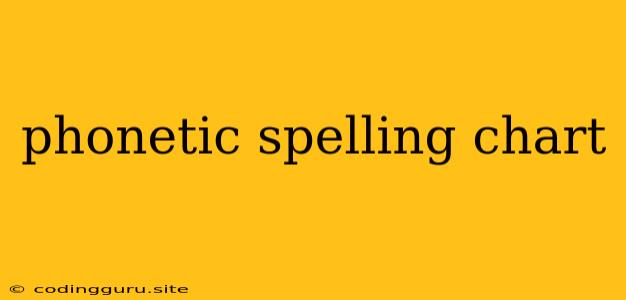Navigating the World of Sounds: A Comprehensive Guide to Phonetic Spelling Charts
Have you ever stumbled upon a word in a text or a dictionary and found yourself completely unsure how to pronounce it? Or maybe you've tried to write down a word that you heard spoken, but you couldn't quite capture the exact sound? This is where phonetic spelling charts come into play. These handy tools provide a visual representation of how sounds are made, helping you to understand and reproduce them with accuracy.
What is a Phonetic Spelling Chart?
A phonetic spelling chart, also known as a phonetic alphabet or sound chart, is a system that uses symbols to represent each individual sound in a language. It's like a codebook for sounds, where each symbol corresponds to a unique pronunciation. This system is particularly useful for:
- Learning a new language: It helps you to grasp the pronunciation of words and understand the subtle differences in sounds that might be unfamiliar.
- Improving your own pronunciation: By understanding the symbols, you can analyze your own speech patterns and identify areas where you might need to adjust.
- Transcribing speech: Phonetic spelling charts are essential for transcribing spoken language, especially for dictionaries, linguistic analysis, and speech therapy.
How to Read a Phonetic Spelling Chart:
The most widely recognized phonetic spelling chart is the International Phonetic Alphabet (IPA). The IPA employs a system of symbols, many of which are derived from the Roman alphabet, to represent every known sound in human language.
Here's a simple breakdown:
- Vowels: Vowel sounds are represented by symbols like /a/, /i/, /u/, /e/, and /o/.
- Consonants: Consonants are represented by symbols like /p/, /b/, /t/, /d/, /k/, /g/, /m/, /n/, /s/, and /l/.
Each symbol has a specific location and manner of articulation, which determines the sound it represents. For instance, the symbol /p/ represents a voiceless bilabial stop, meaning it is produced by stopping the airflow with both lips.
The Importance of Phonetic Spelling Charts:
Phonetic spelling charts are a powerful tool for anyone interested in language. They provide a standardized system for representing sounds, making it easier to:
- Communicate effectively: By understanding the sounds of a language, you can pronounce words more accurately and be understood more clearly.
- Learn new languages: The IPA can be used to learn the pronunciation of words in any language, making it an invaluable resource for language learners.
- Study the evolution of language: By examining the phonetic spelling of words across different time periods, linguists can track how languages have changed over time.
Exploring Phonetic Spelling Charts:
The International Phonetic Alphabet is widely used in linguistics, dictionaries, and speech therapy. However, it is important to note that phonetic spelling charts can vary slightly depending on the specific language or dialect being represented.
Here are a few tips for utilizing phonetic spelling charts effectively:
- Start with the basics: Begin by focusing on the vowel and consonant sounds that are most common in your target language.
- Practice regularly: The more you use a phonetic spelling chart, the more familiar you will become with the symbols and the sounds they represent.
- Seek out resources: There are many online resources and textbooks that provide detailed explanations of phonetic spelling charts and how to use them.
Conclusion:
Phonetic spelling charts are essential tools for anyone who wants to understand and communicate effectively. By learning to use them, you can improve your pronunciation, learn new languages, and gain a deeper understanding of the sounds of human speech. So, dive into the world of phonetic spelling charts and discover the beauty and complexity of language!
